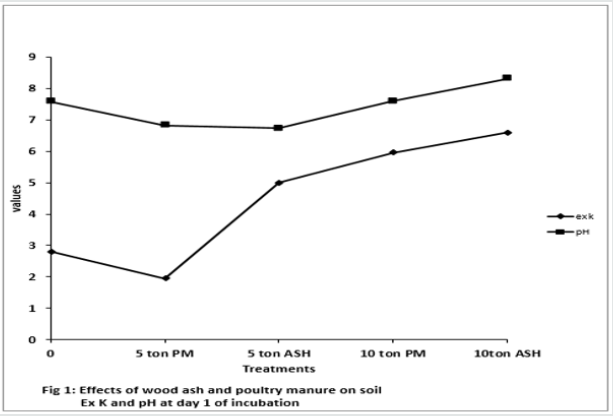
Lupine Publishers Group
Lupine Publishers
Menu
ISSN: 2637-4676
Research Article(ISSN: 2637-4676) 
Comparative Effects of Wood Ash and Poultry Manure on Soil Ph and Potassium Release from an Acid Ultisol in Umudike, Abia State, Nigeria Volume 8 - Issue 2
Akinmutimi Al* and Ukonu A
- Department of Soil Science and Meteorology, Michael Okpara University of Agriculture, Umudike, Nigeria
Received: February 04, 2020; Published: February 18, 2020
Corresponding author: Akinmutimi Al, Department of Soil Science and Meteorology, Michael Okpara University of Agriculture, Umudike, Nigeria
DOI: 10.32474/CIACR.2020.08.000283
Abstract
An experiment was conducted at Michael Okpara University of Agriculture, Umudike soil science Laboratory to study the effects of poultry manure and wood ash on soil exchangeable potassium and soil pH. The aim was to compare the effects of poultry manure and wood ash on soil pH and the rate of potassium- release with time, from an acid ultisol in Umudike, Abia State. The organic amendments were poultry manure and wood ash which were applied at the rates of 0, 5 and 10 tons per hectare. The treatments were replicated three times in a completely randomized design (CRD). During the experiment, soil samples were collected from the incubated samples and analyzed for pH and exchangeable potassium at day 1, day 14, day 28 and day 42. The results showed that poultry manure and wood ash had good effects by improving the soil pH and exchangeable potassium. 10 tons/ha rate of application of both gave highest values of soil exchangeable potassium and pH at one time or the other throughout the incubation period. 10 tons/ha of poultry manure and wood ash were therefore recommended.
Introduction
Most parts of the world’s cropland have become either abandoned or unproductive due to one form of degradation or another. Continuous use of chemicals, fertilizers and pesticides over the years had lead to soil acidification Maruthi et al. [1]. Most soils in southeastern Nigeria are acidic Owolabi et al., [2]. This is mainly due to the type of parent materials, heavy leaching and weathering processes Fitz Patrick [3]. Acidification is a natural and ongoing process in soils Wortmann et al., [4]. Mayz and Cartwright [5]. reported that increased soil acidity leads to low pH, increase availability of aluminum or potassium to the point of toxicity and deficiency of potassium, phosphorus, calcium, copper and molybdenum. Soil is acidic because of the composition of their parent materials which they are formed from Spies and Harns [6]. Ohiri and Ano attributed the acidic nature of soil in southeast Nigeria to their parent material, leaching and degradation in soil physical properties. The use of organic manure in form of poultry manure and wood ash had been found to complement the inorganic fertilizer as both manures improve crop yield Meludu [7], Odiete et al., [8]. Omisore et al., [9], in his research discovered that poultry manure is the best valuable of all animal manures. He also stated that poultry manure improves biological activities, soil tilth and chemical properties. Ibeawuchi [10], stated that poultry manures supplies essential nutrients especially nitrogen, phosphorus, potassium (NPK) required for maximum production. Onwuka et al., [11] and Akinmutimi et al. [12], on their own have also established the usefulness of ash in ameliorating soil acidity in the southeastern Nigeria. However, this work is carried out to compare the effects of Ash and Poultry manure on soil pH and potassium release.
Objective of the Study
a) To compare the effect of ash and poultry manure on
the rate of potassium-release with time from acid ultisol in
Umudike, Abia State.
b) To determine the effect of ash and poultry manure on soil
pH in relation to time in an acidic ultisol in Umudike, Abia State.
Materials and Methods
Experimental site
a) Study area
The study was conducted at the Michael Okpara University of Agriculture, Umudike, Abia State. Umudike lies within latitude 05029’N and on longitude 07033’E, with an altitude of 122m above the sea level (NRCRI, 2007).
b) Climatic condition of the site
The climate of Umudike is essentially humid rainforest; this is due to the fact that it is located within the tropical rainforest zone with a mean annual rainfall range of 1512-2731mm, which is distributed over nine to ten months in a bimodal rainfall pattern. These are the early rains (April-July) and late rains (August- October) with five months of dry season and a short dry spell in August, popularly called August break. The monthly minimum air temperature ranged from 200C to 240C while the monthly maximum air temperature ranged from 280C to 350C. The relative humidity varies from 51% to 87%. The average sunshine hours vary from 3 to 7 and appeared always lowest in the months of July, August and September and highest in the month of May NRCRI [13].
c) Soil sampling: The bulk soil sample was collected from Michael Okpara University of Agriculture, Umudike Eastern farm, at a depth of 0-15cm. The sample was air-dried and sieved using a 2mm sieve.
d) Treatments: The treatments consisted of poultry manure and wood ash, at the application rates of 0, 5 and 10 tons per hectare.
e) Poultry manure: Poultry manure was collected from Michael Okpara University of Agriculture poultry farm (Battery cage section), Umudike.
f) Wood ash: Wood ash was collected from a local kitchen in Umugbalu and Umudike all in Ikwuano L.G.A, Abia State.
g) Laboratory analysis: The following methods were used during the soil physical and chemical analysis.
Soil physical analysis
a. Particle size analysis (bouyoucos [14]): The soil texture was determined using the hydrometer method of Bouyoucos [14].
Chemical analysis
a. soil ph determination (jackson [15]): The soil pH was determined using the glass electrode pH meter (Jackson, 1964) in ratio of 1:2.5 (soil: water / KCl).
b. Exchangeable acidity (Al3+ and H+) (Mclean [16]): Soil exchangeable acidity (Al3+ and H+) was determined by titration method as described by Mclean [16].
c. Organic carbon (walkley and black, [17]): The organic carbon was determined using dichromate wet oxidation method (Walkley and Black, [17]).
d. Total Nitrogen: The soil total nitrogen was determined using the micro-kjeldahl digestion and distillation method as described by Jackson [15].
e. Available phosphorus (bray and kurtz, [18]): This was determined using Bray as described by Bray and Kurtz (1945).
f. The exchangeable bases (chapman [19]): The Exchangeable cations were extracted using ammonium acetate method (1N NH4OAc) at pH 7.
g. Effective cation exchange capacity (ECEC):
Effective cation exchange capacity was calculated as the sum of exchangeable bases (Ca, Mg, K, and Na) and exchangeable acidity expressed in cmolkg-1 as explained by Summer and Miller [20].
h. Base saturation
Percentage base saturation was determined using the equation:

Analysis of the organic amendments
Poultry manure and ash used in this study were subjected to chemical analysis in the laboratory. They were analyzed for the following: pH, total nitrogen, phosphorus, organic carbon, potassium, magnesium and sodium.
Incubation experiment
This was carried out in the soil science laboratory of Michael Okpara University of Agriculture, Umudike, Abia State. 50g of the sieved soil sample was weighed out into plastic containers of equal sizes and basal diameter and labeled properly. This was incubated with each of the organic amendments. (Poultry manure, wood ash) applied at the rates of 0, 5, and 10 tons per hectare. The treatment was replicated three times in a completely randomized design (CRD). The samples were moistened to field capacity and covered with a porous material to minimize evaporation.
Analysis of Soil samples during the incubation experiment
Soil samples were collected from the incubated samples and analyzed for soil pH and Exchangeable potassium at 1 day, 14 days, 28 days and 42 days of incubation.
Statistical analysis
Data generated from the laboratory analysis were subjected to analysis of variance (ANOVA) and the treatment means were separated using the fisher’s least significant difference (FLSD) at 5% level of probability.
Soil physical chemical properties
Table 1 shows the physical and chemical properties of the soil before treatment application. The particle size distribution of the soil showed that the percentage of sand was 81.8 while that of silt and clay were 11.4 and 6.8 respectively. Using the textural triangle, the soil was shown to have a texture of loamy sand. The soil pH in water was 5.13 indicating that the soil is strongly acidic. Organic carbon and total nitrogen contents of the soil were also low, and available phosphorus was moderate (Akinrinde and Obigbesan [21]. Percentage calcium, and magnesium were low and sodium and potassium were moderate.
Table 1: Some physical and chemical properties of the soil before treatment application.
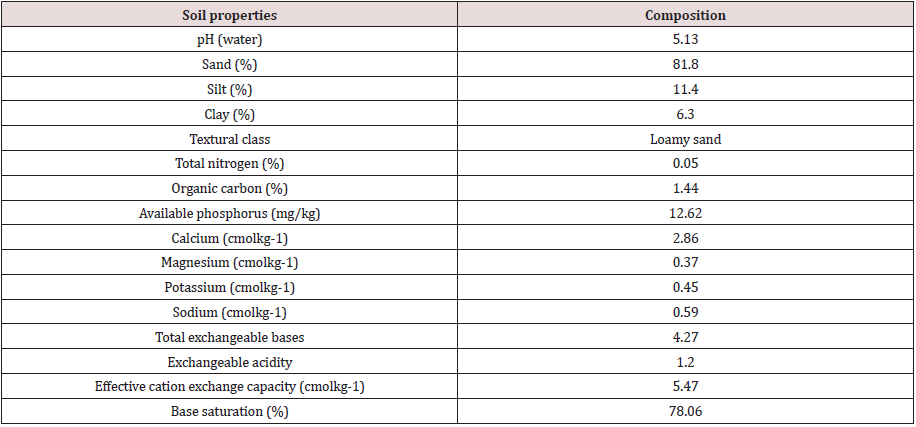
Source: Food Crop and Fishery Services [11].
The chemical composition of the materials used for the experiment
The chemical composition of the materials used in the experiment is shown in Table 2. From the table, poultry manure has higher values in available phosphorus and potassium and calcium while wood ash has values of magnesium, sodium, organic carbon and pH. The high levels of the parameters assayed in the wood ash and poultry manure implies that these organic materials have a high potential to enrich the soil.
Effects of Poultry Manure and Wood ash on the Soil Exchangeable Potassium and PH in the Incubation Experiment
The effects of poultry manure and wood ash on soil exchangeable potassium and pH on day1, day 14, day 28 and day 42 of incubation are presented in (Figures 1-4). 10 tons/ha poultry manure gave the highest values of Exchangeable K on the 14th and 28th day of incubation, while 10 tons/ha wood ash gave the highest values of the same on the 1st and 42nd day of the incubation. Considering the effects of the treatments on soil pH, 10 tons/ha wood ash gave the highest values on the 1st and 28th day of incubation, while 10 tons/ha poultry manure gave the highest pH results on the 14th and 42nd day of incubation. Although the values were not statistically significant among the treatment means. This implies the need to apply more than 5 tons/ha of either the wood ash or the poultry manure to Ultisols such as the one studied, when an experiment is aimed at soil acidity amelioration and soil exchangeable potassium is important. Agbede and Adekiya [22] also advocated a combination of 5 tons/ ha of both wood ash and poultry manure application. Therefore 10 tons/ha of either wood ash or poultry manure application gave higher results [23,24].
Figure 2: Effects of wood ash and poultry manure on soil exchangeable K and pH at day 14 of incubation.
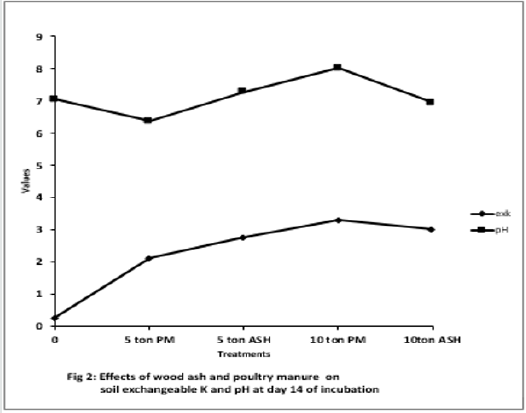
Figure 3: Effects of wood ash and poultry manure on soil exchangeable K and pH at day 28 of incubation.
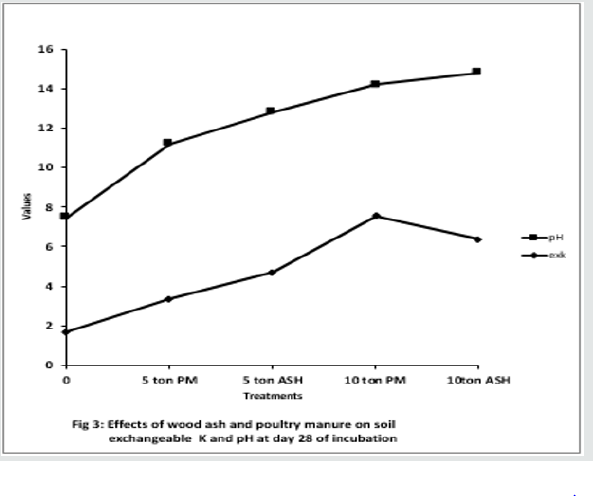
Figure 4: Effects of wood ash and poultry manure on soil exchangeable K and pH at day 42 of incubation.
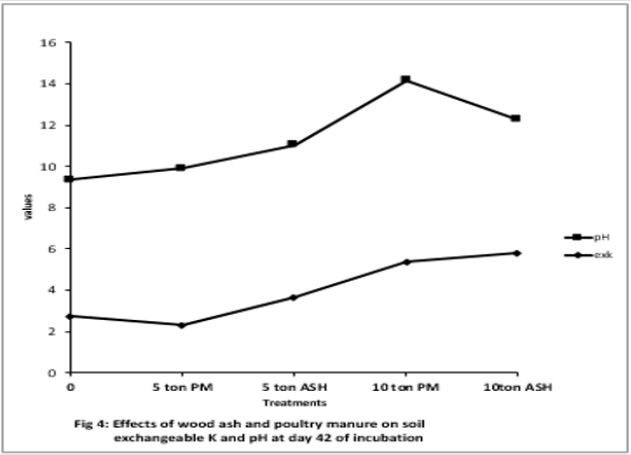
Conclusion
From the results obtained in this experiment, poultry manure and wood ash at 10 tons/ha gave the highest soil exchangeable potassium as well as soil pH, although the values were not significantly higher than those obtained from the rest of the treatments. It can therefore be concluded that 10 tons/ha of either poultry manure or wood ash should be the least application rate when soil acidity amelioration or increased soil exchangeable potassium is desired in an Ultisol like the one studied in this experiment.
References
- Maruthi YA, Sandeeppp G, Chandan SH, Saounyamohan K, Chandana J, et al. (2008) Feasibility of usage of poultry liters manure in agricultural practices. Rasayan J Chan 1(3): 631-635.
- Owolabi O, Adeleye A, Oladijo BT, Ojeniyi SO (2003) Effect of wood ash on soil fertility and crop yield in South West Nigeria. Nigeria journal of soil science 13: 5-59.
- Fitzpatrick EA (1994) An introduction to soil science. Singapore Longman publishers 143-144.
- Wortmann C, Mamo M, Shapiro C (2003) Management strategies to reduce the rate of soil acidification Nebguide GO3-1503.
- Mayz de Manzi J, Cartwright PM (1984) The effect of PH and aluminum toxicity on the growth and symbiotic development of cowpea (Vigna ungniculata (L) (Walp). Plant and Soil 80(3) 423-430.
- Spies, Harns (2001) Effect of soyabean on subsequent maize grain yield in guinea savannah zone of West Africa. Afr Crop Science JS 31-38.
- Meludu NT (2005) Use of human waste in sustainable crop production in Niger. J Environ Extension 5: 65-7.
- Odiete, I, Chude VO, Ojeniyi SO, Okozi A A, Hussani GM (2005) Response of maize to nitrogen and phosphorus sources in Guinea savanna zone of Nigeria. Niger J Soil Sci 15: 90-101.
- Omisore JK Oyelade OA, Dada Joel OT (2009) Effects of application timing on maize production using poultry manure. National Centre for Agricultural Mechanization (NCAM) Ilorin.
- Ibeawuch II (2009) Effect of increasing poultry manure ratings on the yield components of cucubita maxima in Owerri ultisols. Imo State proceedings of the 43rd Annual conference of the agricultural society of Nigeria 231-233.
- Onwuka MI, Osodeke VE, Ano AO (2010) Assessment of the effect of some liming materials on some soil chemical properties in a degraded ultisol in southeastern Nigeria. N g J Soil Science 20(2): 54-62.
- Akinmutimi AL, Osodeke VE, Ano AO (2013) Yield and nutrient composition of sweet potato Ipomea batatas L lam as influenced by application of three different sources of ash. Greener Journal of Agricultural Sciences 3 (2): 101-109.
- Umudike (2007) Nrcri National Root Crops Research Institute Umudike Bulletin 2007.
- Bouyoucos GH (1951) A recalibration of the hydrometer method for mechanical analysis of soils. AgronJourn 43: 434-438.
- Jackson MC (1964) Soil chemical analysis advanced curses. Pretice Hall New York, USA.
- Mclean EO (1965) All in: Black CA (Ed) methods of Analysis part III.
- Walkey A, Black JA, (1934) An examination of the Degjaref method for determining soil organic matter and proposal modification of the chronic acid titration. Soil Science 37: 29-38.
- Bray RH, Kurtz NT (1945) Determination of total organic and available forms of phosphorus in soil. Science 59(1): 39-45.
- Chapman HD (1965) Total exchangeable bases in: Black CA (ed) method of analysis. Part II Am Soc Agron 9 Madison 902-904.
- Sumner ME, Miller WP (1996) Cation exchange capacity Methods of soil analysis part 3-chemical methods. SSSA Book series 5 Madison Wisconsin USA 1201-1230.
- Akinrinde EA, Obigbesan, GO (2000) Evaluation of fertility status of selected soil for crop production in five ecological zones of Western Nigeria. Proceedings of the 26th Annual conference of soil science society of Nigeria University of Ibadan 279-288.
- Agbede TM, Adekiya AO (2012) Effect of wood ash poultry manure and NPK fertilizer on soil and leaf nutrient composition growth and yield of Okra (Abelmoschus esculentus). Journal Emirates Journal of Food and Agriculture 24(4): 314-321.
- Soil retrogression and degradation.
- Ojeniyi SO, Oso OP, Arotolu AA (2001) Response of vegetables to wood ash fertilizer. Proceedings of 35th Annual Conference of Agric Society of Nigeria: 39-43.

Top Editors
-

Mark E Smith
Bio chemistry
University of Texas Medical Branch, USA -

Lawrence A Presley
Department of Criminal Justice
Liberty University, USA -

Thomas W Miller
Department of Psychiatry
University of Kentucky, USA -

Gjumrakch Aliev
Department of Medicine
Gally International Biomedical Research & Consulting LLC, USA -

Christopher Bryant
Department of Urbanisation and Agricultural
Montreal university, USA -

Robert William Frare
Oral & Maxillofacial Pathology
New York University, USA -

Rudolph Modesto Navari
Gastroenterology and Hepatology
University of Alabama, UK -

Andrew Hague
Department of Medicine
Universities of Bradford, UK -

George Gregory Buttigieg
Maltese College of Obstetrics and Gynaecology, Europe -

Chen-Hsiung Yeh
Oncology
Circulogene Theranostics, England -
.png)
Emilio Bucio-Carrillo
Radiation Chemistry
National University of Mexico, USA -
.jpg)
Casey J Grenier
Analytical Chemistry
Wentworth Institute of Technology, USA -
Hany Atalah
Minimally Invasive Surgery
Mercer University school of Medicine, USA -

Abu-Hussein Muhamad
Pediatric Dentistry
University of Athens , Greece

The annual scholar awards from Lupine Publishers honor a selected number Read More...





